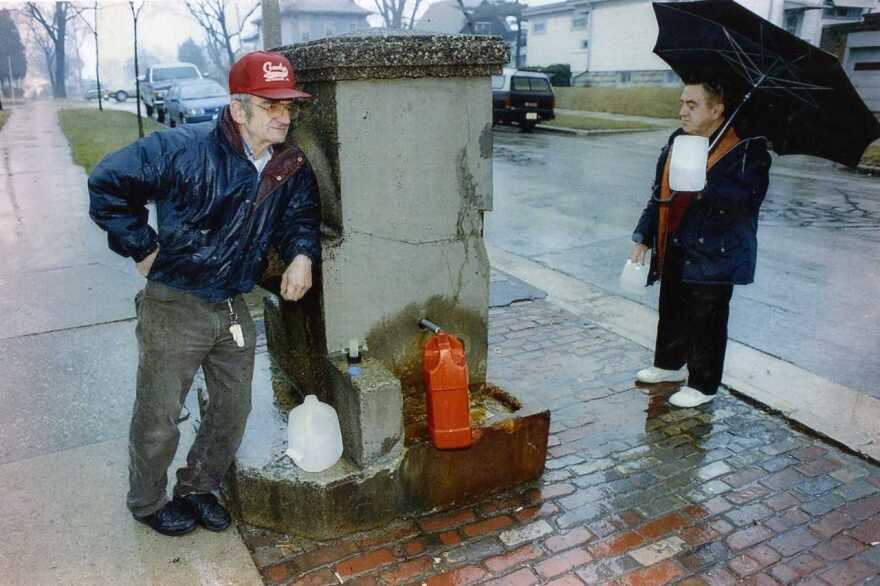Both cryptosporidium and lead have threatened Milwaukee’s clean drinking water. While there are stark differences in the two water contaminants, what can we learn from how the city dealt with both?
First, it’s important to state that cryptosporidium and lead are completely different.
Crypto is a bacteria. Lead is a metal. Crypto has one parasitic source, while lead has many (paint, dust, dirt, pipes). Crypto makes people visibly sick, but lead can be in the body for a long time without showing any side effects.
Both crypto and lead are widespread risks that reveal vulnerabilities in Milwaukee’s drinking water infrastructure.
Cryptosporidium
Let’s start by looking back at the cryptosporidium outbreak in the spring of 1993.
“We had many people coming in with severe stomach issues, and the advice given out by a pharmacist or doctor would be told to drink water, stay hydrated, drink more water, take Imodium, you’ll feel better in a few days," recalls Dawn, a pharmacy technician in Milwaukee during the outbreak. "We didn't realize that we were kind of perpetuating [it]. It just kept going and going."

Cryptosporidium is a type of parasite found throughout many lakes, rivers, streams, and even in soils, according to Paul Biedrzycki. He was the manager of Environmental Health for the city of Milwaukee during the outbreak.
» 'It's Something I'll Never Forget': Cryptosporidium's Impact On Milwaukeeans
The symptoms of crypto include watery, profuse diarrhea, fever, abdominal cramping and headache. Biedrzycki notes that cryptosporidiosis can be very severe — and even fatal. Children, pregnant women, and people who are immunosuppressed, like those with HIV or AIDS, are especially at risk.
400,000 people sickened. Over 4,000 hospitalized. 104 deaths recorded. Over 700,000 days lost at school or work
"A Confluence of Events"
While the exact cause of crypto is still up for debate, Biedrzycki notes that events like increased rain and snowmelt, high rivers and their pollutants, sewage overflows and diversions resulted in a large contaminated brown plume entering near shore Lake Michigan.

"The water intakes for either treatment plant are located offshore, at that time in a fairly short distance offshore and fairly shallow water," notes Biedrzycki.
Cryptosporidium was considered a subtropical disease, so it wasn't really on our radar in the United States. However, the city of Milwaukee had some idea something widespread was occurring after becoming aware of widespread illness, absenteeism rates, and complaints made to Milwaukee Water Works.
"In retrospect, we now realize that complaints about odor, water color and water taste were being made to the water utility weeks in advance,” says Biedrzycki.
Biedrzycki says the outbreak could have been identified sooner if communication was more open between city health professionals and the water utility.
“This difference in cultures between water utility professionals and public health professionals certainly played a role in impeding or inhibiting early warning detection related to this outbreak,” he says.
Post-Cryptosporidium Changes:
- Extension of water intakes further and deeper into Lake Michigan
- $90 million spent on upgrading both water treatment facilities, including new filtration systems and additional disinfectants to supplement chlorine
- Interagency workgroups created between the city of Milwaukee Health Department and the water utility to promote open communication and information sharing regularly
- Increased risk messaging to vulnerable populations
This outbreak was the largest in North America and there was no rulebook to follow in how to combat it. In retrospect, the city did the best they could with the information they had, says Biedrzycki, and the best takeaway from responding to crypto is to make sure there are no disconnects between the city and public health.
“Connecting the dots between health, the economy and social fabric really was incredibly important. And again, I think those threads have been connected. I don't think they're optimally reinforced, even today given how the Cryptosporidium outbreak is becoming a distant memory for many of us," he says.
Lead Pipes
Lead pipes also pose a risk to drinking water and they have for a long time. But in 2015, the city discovered that its standard practice when fixing water mains was disturbing lead lateral pipes — causing elevated lead levels in the water.
» What Milwaukee's Lead Problem Means For Children
» Live In An Older Home? Milwaukee Mayor Recommends Water Filter To Remove Possible Lead
» Two Takes On Milwaukee's Lead In Water Challenge
» Community Groups Take Action As Milwaukee Leaders Sort Out Childhood Lead Program
Currently, the city doesn't have a systematic plan to completely eradicate lead laterals. Instead, it's replacing lead service lines only when and where there's a break.
So, what can the comparison between cryptosporidium and lead tell us? For one, crypto was framed as an urgent public health emergency — there was a boil water advisory and a water treatment plant closed. Lead is being framed as a non-urgent water utility infrastructure issue — the city is slowly replacing pipes but doesn't have a timely action plan to eliminate lead service lines in Milwaukee.
In the wake of both incidents, city officials are confident in Milwaukee's water quality.
"We are consistently looking at opportunities and become smarter and make sure it is the best drinking water," says Karen Dettmer, supervisor of Milwaukee Water Works.
Despite this assurance, there are still people who pause at the faucet today. Whether it’s because they lived through the crypto outbreak in 1993 or because they think the city isn't doing enough to address lead in the water.





